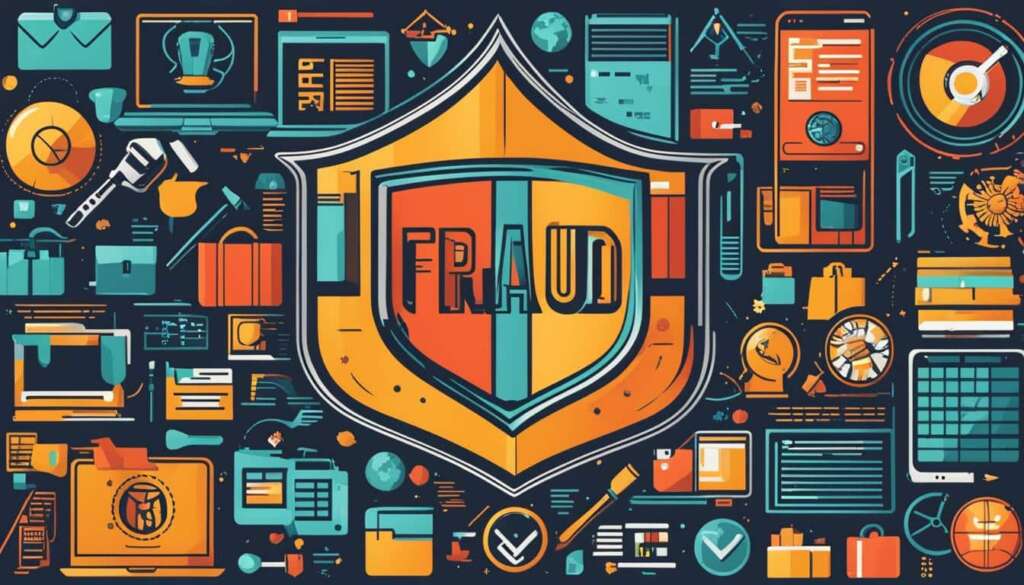Table of Contents
In today’s digital age, e-commerce has revolutionized the way we shop and conduct business. However, along with its numerous benefits, e-commerce also brings its fair share of challenges and risks. One of the most prominent risks is e-commerce fraud. To ensure the safety and security of online transactions, it is crucial to understand the various types of e-commerce frauds, the potential risks they pose, and the preventive measures that can be taken to safeguard businesses and customers.
E-commerce fraud refers to the criminal activities that occur within the online shopping and transaction environment. These frauds involve malicious actors exploiting vulnerabilities in digital commerce systems or manipulating businesses and customers to gain unauthorized access to sensitive personal or financial information.
This article will delve into the different types of e-commerce fraud, the potential risks they pose to businesses, and the measures that can be taken to prevent and detect such fraudulent activities. By gaining a comprehensive understanding of e-commerce frauds and implementing the right preventive measures, businesses can protect themselves and their customers, ensuring a secure and trustworthy online shopping experience.
What is Ecommerce Fraud?
Ecommerce fraud is a form of criminal activity that occurs within the digital landscape of online shopping and transactions. It involves malicious individuals who exploit vulnerabilities in ecommerce systems, manipulate businesses, and deceive customers to gain unauthorized access to sensitive personal or financial information. This type of fraud can have severe consequences for both businesses and their customers, including unauthorized transactions, financial losses, and damage to the reputation of affected companies.. It is a pressing concern for any entity that operates online, as it can significantly impact customer trust, security, operational costs, and ultimately, the overall success of the business.
Ecommerce fraud can take various forms and employ different tactics, all aimed at illegally obtaining valuable information or financial gains. Some examples of ecommerce fraud include identity theft, credit card fraud, chargeback fraud, phishing and social engineering, account takeover fraud, refund fraud, affiliate fraud, counterfeit or fake products, and drop-shipping fraud.
To illustrate the seriousness of ecommerce fraud, consider the following statistics:
| Ecommerce Fraud Statistics | |
|---|---|
| Over £1.5 billion lost to ecommerce fraud in the UK in 2020 | |
| 80% increase in ecommerce fraud attempts in the UK in 2020 | |
| More than 40% of global businesses experienced ecommerce fraud in 2020 | |
| Identity theft accounted for 39% of reported ecommerce fraud cases in 2020 |
As these statistics demonstrate, ecommerce fraud poses a significant threat to online businesses and their customers. To combat this growing problem, it is essential for businesses to have a clear understanding of ecommerce fraud and take proactive measures to prevent and detect fraudulent activities.
Types of Ecommerce Fraud
When it comes to ecommerce fraud, there are several types of fraudulent activities that both businesses and customers should be aware of. Understanding these types can help businesses implement effective prevention and detection strategies. Let’s take a closer look at some of the common types of ecommerce fraud:
- Identity Theft: This involves the fraudulent acquisition and use of someone else’s personal information, such as name, address, and financial details, to conduct unauthorized transactions.
- Credit Card Fraud: Fraudsters obtain credit card information and use it to make unauthorized purchases or create counterfeit cards.
- Chargeback Fraud: Fraudsters make a purchase with a credit card and subsequently dispute the charge, resulting in a chargeback and financial loss for the merchant.
- Account Takeover Fraud: Fraudsters gain access to a customer’s account, either by obtaining login credentials or through other means, to make unauthorized transactions or steal personal information.
- Phishing and Social Engineering: Fraudsters trick individuals into revealing their personal information or login credentials through deceptive emails, messages, or phone calls.
- Refund Fraud: This involves requesting refunds for items that were never purchased or returning counterfeit or damaged products to receive a refund.
- Affiliate Fraud: Fraudsters manipulate affiliate marketing programs to generate fake leads or sales and earn illegitimate commissions.
- Counterfeit or Fake Products: Fraudsters sell counterfeit or fake products, often imitating popular brands, to unsuspecting customers.
- Drop-shipping Fraud: Fraudsters use stolen credit cards to purchase products and have them shipped directly to their own address, without the knowledge of the cardholder or the merchant.
These types of ecommerce fraud involve various tactics and methods employed by fraudulent actors to exploit vulnerabilities in online transactions and systems. It is crucial for businesses to understand these types in order to develop robust prevention and detection measures.

Main takeaways:
- Ecommerce fraud encompasses various types, including identity theft, credit card fraud, chargeback fraud, and more.
- Each type of fraud involves different tactics and methods used by fraudulent actors.
- Understanding these types is essential for implementing effective prevention and detection strategies.
Ecommerce Fraud Trends and Future Predictions
Ecommerce fraud is a constantly evolving threat, with fraudsters continuously developing new tactics and methods to conduct fraudulent activities. Understanding the current trends and future predictions is crucial for businesses to stay one step ahead and protect themselves and their customers from potential fraud.
Current Trends in Ecommerce Fraud
- The Growing Sophistication of Attacks: Fraudsters are becoming more sophisticated in their techniques, utilizing advanced tools and strategies to bypass security measures and exploit vulnerabilities in ecommerce systems.
- Rise in Mobile Commerce Fraud: With the increasing use of smartphones and mobile devices for online shopping, fraudsters are targeting mobile platforms, taking advantage of the vulnerabilities in mobile payment systems.
- Increased Use of AI and Machine Learning: Both businesses and fraudsters are leveraging artificial intelligence and machine learning technologies to automate fraud detection and evasion, respectively.
- Growth in Account Takeover Fraud: Data breaches and compromised accounts have led to a rise in account takeover fraud, where fraudsters gain unauthorized access to legitimate user accounts to make fraudulent transactions.
- Focus on Data Security and Privacy Regulations: The introduction of strict data security and privacy regulations, such as GDPR, has compelled businesses to strengthen their security measures and protect customer data.
- Collaboration and Information Sharing: Businesses and financial institutions are increasingly collaborating and sharing information about fraudulent activities to collectively combat ecommerce fraud.
- Role of Biometrics and Behavioral Analytics: Biometric authentication and behavioral analytics are gaining prominence in fraud detection and prevention, offering enhanced security and identifying patterns indicative of fraudulent behavior.
To provide a visual representation of these trends, here is a table summarizing their key features:
| Trend | Description |
|---|---|
| The Growing Sophistication of Attacks | Fraudsters using advanced techniques to bypass security measures |
| Rise in Mobile Commerce Fraud | Fraud targeting vulnerabilities in mobile payment systems |
| Increased Use of AI and Machine Learning | Automation of fraud detection and evasion |
| Growth in Account Takeover Fraud | Fraudsters gaining unauthorized access to legitimate user accounts |
| Focus on Data Security and Privacy Regulations | Stringent regulations requiring improved security measures |
| Collaboration and Information Sharing | Businesses and financial institutions cooperating to combat fraud |
| Role of Biometrics and Behavioral Analytics | Enhanced security through biometric authentication and behavioral analysis |
Future Predictions for Ecommerce Fraud
“As ecommerce continues to grow, so will the prevalence and sophistication of fraud. Businesses must be prepared to adapt to emerging risks and employ advanced technologies to prevent and detect fraudulent activities.” – Industry Expert
- Increase in Synthetic Identity Theft: Fraudsters will employ advanced techniques to create synthetic identities, making it harder to detect fraudulent activities.
- Rise of Social Engineering Attacks: Fraudsters will increasingly use manipulative tactics to deceive individuals and gain access to sensitive information.
- Emergence of New Payment Methods: The development of new payment methods, such as cryptocurrency, will introduce new vulnerabilities and opportunities for fraud.
- Continued Growth of Mobile Commerce Fraud: With the expansion of mobile commerce, fraudsters will continue to exploit vulnerabilities in mobile platforms.
- Advancements in Fraud Detection Technologies: Businesses will leverage advanced technologies such as machine learning, AI, and big data analytics to strengthen fraud prevention and detection capabilities.
- Shift Towards Continuous Authentication: Continuous authentication methods, such as behavioral biometrics, will gain prominence in verifying users’ identities and detecting fraudulent activities.
To summarize these future predictions, here is a table highlighting the key forecasts:
| Prediction | Description |
|---|---|
| Increase in Synthetic Identity Theft | Fraudsters using advanced techniques to create synthetic identities |
| Rise of Social Engineering Attacks | Manipulative tactics to deceive individuals and gain access to sensitive information |
| Emergence of New Payment Methods | Introduction of new payment methods with associated vulnerabilities |
| Continued Growth of Mobile Commerce Fraud | Exploitation of vulnerabilities in mobile commerce platforms |
| Advancements in Fraud Detection Technologies | Utilization of machine learning, AI, and big data analytics for fraud prevention |
| Shift Towards Continuous Authentication | Verification of user identities and detection of fraudulent activities through continuous authentication methods |
Ecommerce Fraud Prevention and Detection
E-commerce fraud prevention and detection are essential for online businesses to safeguard themselves and their customers from fraudulent activities. By implementing a combination of strategies and tactics, businesses can minimize the risk of ecommerce fraud. Key measures include:
- Using secure payment gateways with built-in fraud detection tools.
- Implementing strong authentication measures such as unique and robust passwords and multi-factor authentication (MFA) to verify user identity.
- Monitoring transactions and user behavior for unusual patterns or suspicious activities.
- Analyzing customer data to identify red flags and high-risk orders.
- Tracking IP addresses for location inconsistencies and multiple purchase attempts.
- Keeping a record of fraudulent activities in different regions.
- Utilizing available tools and resources like CAPTCHA and secure authentication protocols.
- Requiring CVV codes and employing address verification services (AVS) for added security.
- Partnering with reputable payment processors to ensure secure transactions.
- Maintaining website security with firewalls and adhering to PCI-DSS compliance.
- Regularly updating technology and security systems to stay ahead of evolving threats.
By integrating these prevention and detection measures into their operations, businesses can significantly mitigate the risks associated with e-commerce fraud. It demonstrates a commitment to protecting the interests of both the business and its customers.
Protecting your business from e-commerce fraud requires vigilance and continuous improvement in security practices. While no system is entirely foolproof, proactive measures significantly reduce the likelihood of falling victim to fraudulent activities. Implementing robust prevention and detection strategies creates a secure online environment for customers and promotes trust in your brand.
Industry Best Practices for Ecommerce Fraud Detection
In addition to the strategies and tactics mentioned in the previous section, implementing the industry best practices for ecommerce fraud detection is crucial for online businesses. By following these effective practices, businesses can enhance their ability to detect and prevent fraudulent activities, protecting both themselves and their customers.
Analyzing Customer Data
One of the key best practices for fraud detection in ecommerce is analyzing customer data. By thoroughly examining customer information, businesses can identify high-risk orders that may be indicative of fraudulent activity. This analysis involves scrutinizing factors such as order frequency, purchase patterns, shipping address consistency, and payment method history.
Monitoring IP Addresses
Monitoring IP addresses is another effective practice for fraud detection. Inconsistencies in IP addresses, such as multiple purchase attempts from different locations, can raise red flags. This practice helps identify potential fraudulent activities and enables businesses to take appropriate action in real-time to protect their systems and customers.
Tracking Fraudulent Activity
Keeping track of fraudulent activity across different regions is essential for effective fraud detection. By actively monitoring and documenting instances of fraud, businesses can identify patterns and trends, allowing them to proactively implement preventive measures. This practice also facilitates collaboration with other businesses and financial institutions to stay ahead of evolving fraud techniques.
Utilizing Available Tools and Resources
There are various tools and resources available to aid in ecommerce fraud detection. CAPTCHA and secure authentication protocols can help verify the legitimacy of users, while requiring CVV codes and utilizing address verification services (AVS) adds an extra layer of security. Partnering with reputable payment processors that offer robust fraud detection systems can also significantly enhance the effectiveness of fraud prevention measures.
Maintaining Security Measures
Maintaining strong security measures is crucial for effective fraud detection. This includes keeping websites secure with firewalls, regularly updating technology and security systems, and adhering to the Payment Card Industry Data Security Standard (PCI-DSS) compliance. By staying up-to-date with the latest security practices, businesses can minimize vulnerabilities and protect themselves from emerging fraud techniques.
| Best Practices | Description |
|---|---|
| Analyzing Customer Data | Thoroughly examining customer information to identify high-risk orders. |
| Monitoring IP Addresses | Tracking inconsistencies in IP addresses to detect potential fraudulent activities. |
| Tracking Fraudulent Activity | Keeping record of fraudulent activity across regions to identify patterns and trends. |
| Utilizing Available Tools and Resources | Using CAPTCHA, secure authentication protocols, CVV codes, AVS, and partnering with reputable payment processors. |
| Maintaining Security Measures | Ensuring website security, regular technology updates, and complying with PCI-DSS. |
Implementing these industry best practices for ecommerce fraud detection can significantly enhance a business’s ability to detect and prevent fraudulent activities. By staying informed, leveraging available tools, and maintaining robust security measures, businesses can minimize risks and create a secure online shopping environment for their customers.

How to Identify Ecommerce Fraud Online
As an online merchant, it is important to be able to identify potential e-commerce fraud. By recognizing the signs of ecommerce fraud, you can take proactive steps to protect your business and customers. Here are some common signs to watch out for:
- Inconsistent order data: Pay attention to orders with mismatched zip codes and IP addresses, as these may indicate fraudulent activity.
- Larger than average orders or multiple units: Unusually large orders or multiple units of the same item could be a red flag for fraud.
- High-risk characteristics: Be cautious of orders for high-value items or multiples of the same product, as these are often targeted by fraudsters.
- Suspicious activity in customer accounts: Unauthorized logins or changes to account details can indicate that someone is attempting to commit fraud.
To effectively identify ecommerce fraud, it’s important to monitor and analyze customer data, IP addresses, and transaction patterns. Look for any unusual patterns or behaviours that deviate from normal customer activity. Implement measures such as manual review processes and fraud detection tools to flag suspicious transactions for further investigation.
“Being able to recognize the signs of ecommerce fraud is crucial in protecting your business from financial losses and fraudulent activity.”
Protecting Your Business: A Case Study
Let’s consider the case of a small online clothing retailer, Vivienne’s Boutique. Vivienne’s Boutique experienced a sudden surge in orders for high-end designer handbags that seemed too good to be true. The orders were unusually large and the billing and shipping addresses didn’t match. Recognizing these as potential signs of ecommerce fraud, the owner of Vivienne’s Boutique decided to investigate further.
By leveraging fraud detection tools and conducting manual reviews, Vivienne’s Boutique was able to identify that these orders were indeed fraudulent. The customers’ credit cards had been compromised, and the fraudulent activity had spread to multiple retailers in the area. By promptly detecting and addressing the ecommerce fraud, Vivienne’s Boutique was able to prevent financial losses and protect their reputation.
Remember, as an online merchant, it is crucial to be vigilant and proactive in recognizing and addressing ecommerce fraud. By staying informed about the signs of ecommerce fraud and implementing effective fraud detection measures, you can protect your business and customers from potential harm.
Conclusion
E-commerce fraud poses significant risks to online businesses, leading to financial losses, reputation damage, and compromised customer trust and security. To combat this threat, it is essential for businesses to have a comprehensive understanding of the different types of e-commerce fraud, stay updated on current trends and future predictions, and implement effective prevention and detection strategies.
By following industry best practices, such as using secure payment gateways with fraud detection tools, implementing strong authentication measures, monitoring transactions and user behavior, and partnering with reputable payment processors, businesses can mitigate the risks associated with e-commerce fraud. Regularly updating technology and security systems, and maintaining compliance with PCI-DSS standards are also vital in ensuring a secure shopping experience for customers.
Vigilance in identifying potential fraud is crucial. Merchants should be alert to signs such as inconsistent order data, unusually large orders, high-risk characteristics, and suspicious activity in customer accounts. Analyzing customer data, IP addresses, and transaction patterns can help in recognizing and addressing potential fraud at an early stage.
By prioritizing e-commerce fraud prevention and staying vigilant in detecting potential fraud, businesses can safeguard themselves and their customers, enhancing trust, security, and the overall success of their online ventures.
FAQ
What is e-commerce fraud?
E-commerce fraud refers to various criminal activities that occur within the online shopping and transaction environment. It involves malicious actors exploiting vulnerabilities in digital commerce systems or manipulating businesses and customers to gain unauthorized access to sensitive personal or financial information.
Why is e-commerce fraud important?
E-commerce fraud can be damaging to businesses and their customers, leading to unauthorized transactions, financial losses, and damage to the reputation of affected businesses. It is a significant concern for any entity that operates online, as it can negatively impact customer trust, security, operating costs, and the overall viability of the business.
What are the types of e-commerce fraud?
The various types of e-commerce fraud include identity theft, credit card fraud, chargeback fraud, account takeover fraud, phishing and social engineering, refund fraud, affiliate fraud, counterfeit or fake products, and drop-shipping fraud. Each type of fraud involves different tactics and methods used by fraudulent actors to exploit vulnerabilities in online transactions and systems.
What are the current trends and future predictions for e-commerce fraud?
Current trends in e-commerce fraud include the growing sophistication of attacks, the rise in mobile commerce fraud, the increased use of artificial intelligence (AI) and machine learning, the growth in account takeover fraud due to data breaches, the increased focus on data security and privacy regulations, collaboration among businesses and financial institutions, and the growing role of biometrics and behavioral analytics in fraud detection and prevention.
How can businesses prevent and detect e-commerce fraud?
Businesses can prevent and detect e-commerce fraud by using secure payment gateways with fraud detection tools, implementing strong authentication measures, monitoring transactions and user behavior, analyzing customer data to identify red flags, monitoring IP addresses for inconsistencies, using available tools and resources, partnering with reputable payment processors, keeping websites secure, and regularly updating technology and security systems.
What are the industry best practices for e-commerce fraud detection?
Industry best practices for e-commerce fraud detection include analyzing customer data, monitoring IP addresses and transaction patterns, keeping track of fraudulent activity in different regions, using CAPTCHA and secure authentication protocols, requiring CVV codes and using address verification services, partnering with reputable payment processors, keeping websites secure with firewalls, and maintaining PCI-DSS compliance.
How can potential e-commerce fraud be identified online?
Potential e-commerce fraud can be identified online by looking for inconsistent order data, larger than average orders or multiple units, high-risk characteristics in orders, and suspicious activity in customer accounts such as unauthorized logins or changes to account details. Monitoring and analyzing customer data, IP addresses, and transaction patterns can help identify potential fraud.
Is e-commerce fraud a significant risk for businesses?
Yes, e-commerce fraud is a significant risk for businesses operating online. It can result in financial losses, damage to reputation, and negative impacts on customer trust and security. Understanding the different types of e-commerce fraud, staying informed about current trends and future predictions, and implementing effective prevention and detection strategies are key for businesses to protect themselves and their customers.













